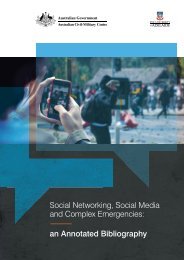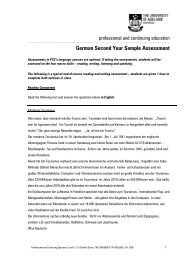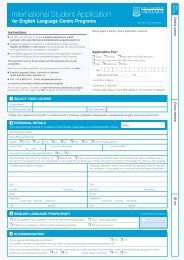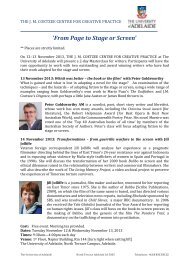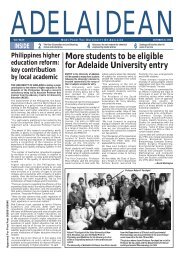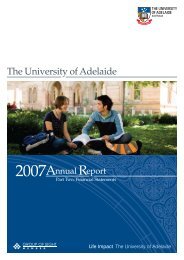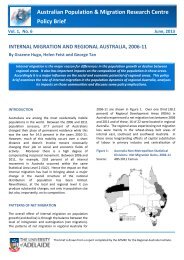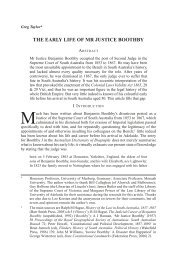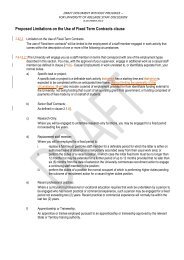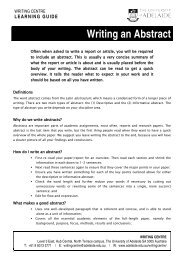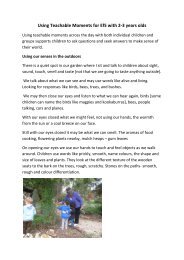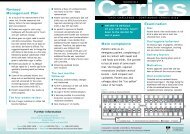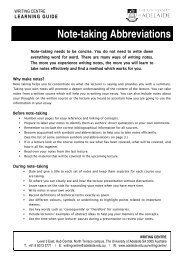Unbridling the Tongues of Women - The University of Adelaide
Unbridling the Tongues of Women - The University of Adelaide
Unbridling the Tongues of Women - The University of Adelaide
Create successful ePaper yourself
Turn your PDF publications into a flip-book with our unique Google optimized e-Paper software.
<strong>The</strong> line <strong>of</strong> least resistance<br />
not to ask John Spence to comment on her fiction until <strong>the</strong> work was complete.<br />
With <strong>the</strong> encouragement <strong>of</strong> a friendly neighbour, to whom she read each chapter as<br />
she finished it, she concluded <strong>the</strong> whole novel in time to despatch it with her friend<br />
John Taylor as he set <strong>of</strong>f for a holiday in England and France, asking him to submit<br />
it to Smith, Elder <strong>of</strong> London and ‘to say nothing to anybody about it’. 14 While she<br />
waited to hear <strong>the</strong> fate <strong>of</strong> that manuscript she began ano<strong>the</strong>r. <strong>The</strong> first, Clara Morison,<br />
was published in 1854; <strong>the</strong> second, Tender and True, in 1856.<br />
That first burst was followed by ano<strong>the</strong>r eight years later, in <strong>the</strong> mid-1860s. Her<br />
third novel, Mr Hogarth’s Will, serialised in <strong>the</strong> Weekly Mail as Uphill Work during<br />
1864, was published in 1865. 15 Her fourth, Hugh Lindsay’s Guest, appeared in serial<br />
form in <strong>the</strong> <strong>Adelaide</strong> Observer during 1867, <strong>the</strong>n as <strong>The</strong> Author’s Daughter in 1868.<br />
She did not write any more extended fiction after that until <strong>the</strong> late 1870s, when she<br />
produced Ga<strong>the</strong>red In in time for Emily Clark to take it on a fruitless search for an<br />
English publisher in 1878. That novel was serialised in <strong>the</strong> <strong>Adelaide</strong> Observer from<br />
September 1881 to March 1882; it was not published in book form until almost a<br />
century later, in 1977. 16 At <strong>the</strong> same time as she was writing that work, she must<br />
have been writing <strong>the</strong> short story ‘Afloat or Ashore’, published in <strong>the</strong> Australasian<br />
in 1878. She submitted her sixth novel, Handfasted for a competition run by <strong>the</strong><br />
Sunday Mail, but unsuccessfully. That book was not published until 1984. 17 Her<br />
last piece <strong>of</strong> extended fiction, a long short story called ‘A Week in <strong>the</strong> Future’ was<br />
serialised in <strong>the</strong> Centennial Magazine in 1888-9, <strong>the</strong>n published as a slender volume<br />
in 1889. By that time, Spence was in her 60s: her mo<strong>the</strong>r had died two years earlier,<br />
removing from her a major constraint on her desire to make a more direct intervention<br />
in <strong>the</strong> world <strong>of</strong> men.<br />
It says much about her sense <strong>of</strong> vocation as a novelist, and <strong>the</strong> support she found<br />
in knowing that she participated in a cosmopolitan world <strong>of</strong> women writers, that she<br />
continued writing fiction for so long. It says much, too, about <strong>the</strong> strength <strong>of</strong> her<br />
sense <strong>of</strong> domestic responsibility and <strong>of</strong> <strong>the</strong> perils <strong>of</strong> venturing outside <strong>the</strong> domestic<br />
sphere, that she persisted in writing fiction at all. <strong>The</strong> tale <strong>of</strong> her negotiations with<br />
her publishers is a sorry one. Smith, Elder & Company refused Clara Morison. <strong>The</strong>ir<br />
chief reader, <strong>the</strong> same William Smith Williams who had declined Charlotte Brontë’s<br />
novel <strong>The</strong> Pr<strong>of</strong>essor, wrote Spence a letter similar to <strong>the</strong> one he had sent Brontë saying<br />
that he thought she could do better. 18 John Taylor left <strong>the</strong> manuscript with ano<strong>the</strong>r<br />
<strong>of</strong> Spence’s Australian friends in London, William Bakewell. He wrote a preface<br />
for it and arranged its publication in two volumes, for which Spence was to receive<br />
45



